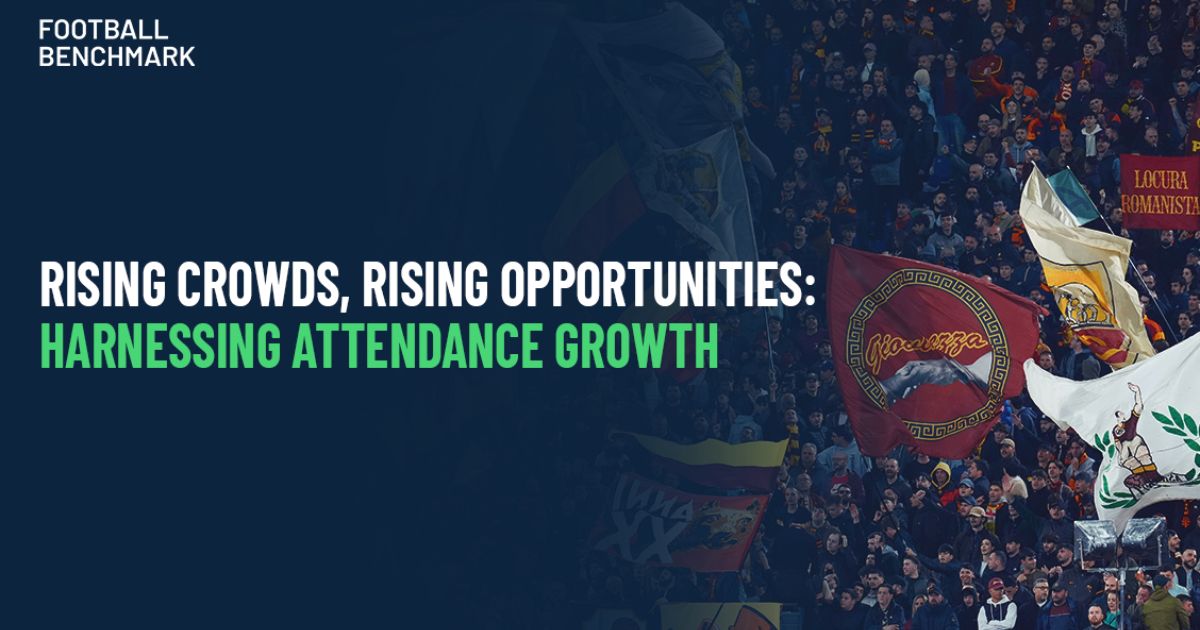Analysis by Football Benchmark
In the 10th edition of Football Benchmark’s Valuation Report, Real Madrid CF reaffirm status as world’s most valuable football club and become first valued over EUR 6 billion.
Key Conclusions:
1) Real Madrid CF lead Football Benchmark’s Football Clubs’ Valuation: The European Elite rankings at EUR 6.3 billion, the highest Enterprise Value ever recorded.
2)Manchester City FC and Manchester United FC complete an unchanged top three, both surpassing the EUR 5 billion mark for the first time, while Aston Villa FC post the highest year-on-year gain.
3) The 10th edition of the report reveals that the Enterprise Value of European top 32 clubs has more than doubled over the past decade (+146%), driven by revenue growth and a sustained increase in transaction multiples.
Real Madrid CF have once again claimed the top spot in Football Benchmark’s annual Football Clubs’ Valuation: The European Elite report, cementing their status as the most valuable football club in the world. With an Enterprise Value (EV) of EUR 6.3 billion, the Spanish giants become the first club ever to surpass the EUR 6 billion mark in the report’s 10-year history.
The top three clubs remain unchanged, with Manchester City FC in second place and Manchester United FC close behind, both surpassing the EUR 5 billion threshold for the first time. Among the top 10, Arsenal achieved the strongest year-on-year growth, rising by 29% to reach 7th place. FC Barcelona climbed to 4th, while Chelsea FC dropped to 10th following an 8% decline.
Aston Villa FC recorded the most significant overall growth in the ranking, up 42% year-on-year. Meanwhile, ACF Fiorentina, PSV Eindhoven and Real Betis Balompié are new entrants to this year’s top 32.
The 10th edition of the annual report not only features the 2025 club ranking but also provides a retrospective of the industry’s transformation over the past decade.
“In the 10th edition of the Valuation Report, we focus on how European football has evolved through a decade of growth, disruption and resilience. The industry has undergone a profound transformation, shaped by regulatory reform, digitalization, the emergence of new competitions and unprecedented commercial expansion. Elite clubs are more valuable and internationally recognised than ever, yet financial sustainability remains the defining challenge ahead. As football cements its status as a global investment asset class, this report not only captures where the game stands today, but also offers a lens into the forces shaping its future.”
Andrea Sartori
Founder & CEO
Football Benchmark I Ace Advisory
Since the inaugural edition of the report in 2016, the total EV of the top 32 clubs has grown by 146% (CAGR 10.5%), reaching EUR 64.7 billion in 2025. This growth has been driven by UEFA and commercial income, along with a sustained increase in transaction multiples observed across the market.
While profitability remains a challenge, with squad costs growing faster than operating revenues (78% vs. 72%), there are signs of improvement. The average squad cost-to-revenue ratio dropped from 95% in 2023 to 82% in 2025.
Other key conclusions from the report:
1) Real Madrid became the first football club to surpass EUR 1 billion in total operating revenues.
2) UEFA’s new Financial Sustainability Regulations, and stricter domestic licensing standards, have played a crucial role in boosting investors’ interest and reinforcing the long-term appeal of European football as an asset class. Between 2016 and 2025, the average EV-to-operating revenue multiple for the top 32 clubs increased from 3.4x to 4.9x.
3) The report notes that elite clubs have cemented their status not just as sporting giants but as global commercial brands. The top 10 clubs by EV generate almost half of their revenue from commercial activities. For smaller clubs, meanwhile, financial sustainability continues to hinge on player trading strategies – a model successfully employed by the likes of SL Benfica, FC Porto and Atalanta BC.
4) Over the past decade, a total of 45 clubs have appeared in the top 32, but only seven countries are represented in the current edition, underscoring a growing financial polarisation. Interestingly, the composition of the top 10 has remained largely stable, with only 11 clubs rotating in and out: the current ten plus Juventus FC.
5) Since our first edition in 2016, Manchester City FC and Real Madrid CF have each increased their EV by more than EUR 3 billion. Tottenham Hotspur FC lead in percentage growth, driven by income from their new stadium, followed by Paris Saint-Germain and FC Internazionale Milano — all of which have seen their EV rise by over 300%.
6) The number of clubs with an EV exceeding EUR 1 billion has more than doubled since 2016, now standing at 17, with the Italian side SSC Napoli being the latest addition to this elite grouping.
Football Clubs’ Valuation: The European Elite 2025
Analysis by Football Benchmark In the 10th edition of Football Benchmark’s Valuation Report, Real Madrid CF reaffirm status as world’s most valuable football club and become first valued over EUR 6 billion. Key Conclusions: 1) Real Madrid CF lead Football Benchmark’s Football Clubs’ Valuation: The European Elite rankings at EUR 6.3 billion, the highest Enterprise Value ever recorded. 2)Manchester City FC and Manchester United FC complete an unchanged top three, both surpassing the EUR 5 billion mark for the first time, while Aston Villa
Rising Crowds, Rising Opportunities: Harnessing Attendance Growth
Analysis of Football Benchmark The booming live event and experience economy is reshaping how consumers prioritise their time and spending — and football is uniquely positioned to benefit from this broader trend. Across Europe’s top leagues, stadiums are now brimming with energy and expectation, as matchday attendance surpasses pre-pandemic norms. This resurgence is more than symbolic. At a time when media rights revenues are plateauing for many clubs and commercial growth is maturing, rising attendances — coupled with a fresh wave
Investing in Portuguese football: a prime spot for Multi-ClubOwnership?
Analysis by Football Benchmark 1. Portugal boasts a strong player development ecosystem, with elite academies consistently producing high-value talent that moves to Europe’s top leagues.2. The country’s historical and linguistic ties to some areas of South America and Africa provide a competitive edge in scouting and integrating emerging talent.3. Favourable regulations, including unrestricted recruitment of non-EU players, enhance Portugal’s appeal as a key market for international talent development.4. The relatively low acquisition costs of Portuguese clubs, coupled with expected revenue growth
SFS SNACK BRUSSELS – Football and Europe: rules, rights and priority
In the prestigious setting of the European Parliament, a symbolic venue for decisions that shape the future of Europe, on 26 March from 16.30 to 18.30 the SFS Snack Brussels, entitled "Football and Europe: rules, rights and priority",presents itself as a key event for debating the governance of European football. At a time of profound regulatory transformations and global challenges, this event offers a unique opportunity to bring together institutions, experts, and key industry players to outline effective strategies for
Breaking down the record-high expenditure in the winter transfer window
After a summer window that saw a 10% drop in spending, the winter window increased by 8% compared to last season, reaching EUR 1.46 billion. As a result, the total transfer expenditure (summer + winter windows) across top-division UEFA leagues and the English Championship shows a 4% overall drop compared to last season reaching EUR 7.87 bn in 2024/25. This represents a slight decline in expenditure for the first time since the pandemic. With the transfer window now closed for
The Business of Football Academies: How Clubs Create Value from Youth Development?
Key insights:- The evolution of Academy players: From "one-club" legends to strategic assets: Academy players are increasingly viewed as commodities rather than potential club legends, becoming integral components of financial strategies and accounting practices. Despite this shift, the role of academies is more significant than ever, as a well-executed youth development strategy can have substantial impact.- Tailoring the Academy vision to club context: There is no universally correct approach to academy development; the most suitable vision depends on each club’s
SFS Announces Strategic Partnership with Football Benchmark
We are thrilled to announce that SFS has entered into a strategic partnership with Football Benchmark, a leading football business advisory firm known for its industry-trusted data and analytics platform. This collaboration represents a significant step forward in our mission to provide unparalleled insights into the rapidly evolving football business landscape. This partnership will come to life at our upcoming event, where we will unveil a series of sessions and panels that will empower attendees with actionable knowledge. With Football Benchmark’s data-driven approach and SFS’s strategic
New ECA report released – Transition from Academy to First Team Football
A new report published today by European Club Association lays bare the challenges facing young players as they make the step up from academy to playing at senior level, possibly the most challenging step during a player’s entire career. The report, Transition from Academy to First Team football, has been produced by ECA in association with Football Benchmark and is the latest in a series of studies by the association on youth football. Ultimately, the key objectives of the study were to










